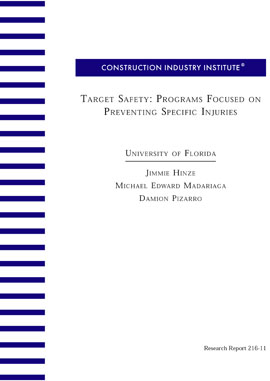
Target Safety: Programs Focused on Preventing Specific Hazards
This research report presents information on safety programs implemented on construction projects to address specific types of hazards. These programs, referred to as Target Safety Programs, are initiated, developed, and implemented to reduce and eliminate injuries that are associated with specific types of jobsite hazards. While most safety techniques are designed to address safety in a generic fashion, target safety programs are focused on specific jobsite hazards. The objective of this study was to develop a guidance model by which any target safety program could be developed and implemented. The results of the research evolved into a series of nine steps that outline the basic sequence for developing and implementing target safety programs.
Chapter 1 provides an introduction to target safety programs. Various statistics about the safety performance of the construction industry are also presented.
Chapter 2 presents a review of the relevant literature on target safety programs. While there are a limited number articles on target safety programs in the literature, the few programs that were located in the literature are briefly described.
Chapter 3 gives the methodology that was used to conduct the research. Most notably, the research effort was conducted as two separate studies. The first consisted of a questionnaire survey that was conducted with various construction firms, involving over 200 construction projects. The second consisted of ten case studies that were conducted to capture detailed information about target safety programs implemented on construction projects.
Chapter 4 presents the results related to the questionnaire survey that was conducted. The most significant findings are presented that provide an overview of how target safety programs are developed and best implemented.
Chapter 5 consists of detailed descriptions of the ten case studies that were conducted. A wide variety of programs are described which demonstrate the versatility with which target safety programs are developed and implemented.
Chapter 6 presents the conclusions to the research effort and the recommendations related to this research study. The most notable conclusion is that the procedures by which target safety programs are developed and implemented are sufficiently uniform that the process can be modeled in a template. The template or model that was developed as part of this research is described in detail in the form of nine distinct steps. The results of this research are sufficiently compelling that it is recommended that the target safety template be utilized whenever a specific jobsite hazard is to be addressed.
The appendices consist of a copy of the questionnaire survey that was used to conduct the first phase of the research. Also presented is the cover letter that accompanied the survey questionnaire. This is followed in the research report by the list of references presented in the literature review.


